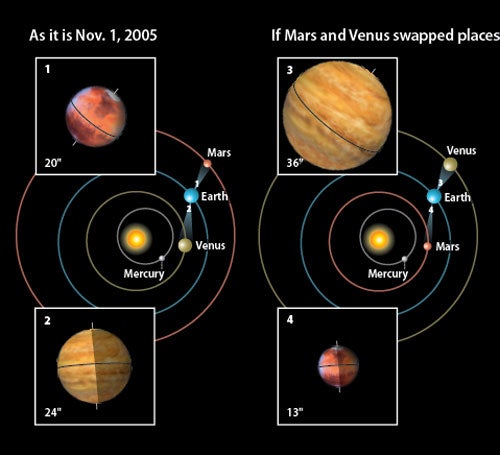The two objects appear bright for somewhat different reasons, and that plays into what they would look like if they could swap places. Although both planets lie close to Earth — a key brightness factor — Mars shines so brightly now because of the “opposition effect,” the tendency of an object to appear brighter when it lies opposite the Sun because all shadows disappear. It’s why the Full Moon shines about 10 times brighter than a half-lit quarter Moon.
Venus, because it lies closer to the Sun than Earth does, never reaches opposition. In fact, if you were to look at it through a telescope at greatest elongation, you would see only a half-lit disk. Venus appears so bright largely because its surface is cloaked in highly reflective clouds. The planet reflects 65 percent of the sunlight that hits it, compared with just 15 percent for Mars.
How would this play out if the two planets switched places? Mars would appear dimmer than it does now and Venus much brighter — but it wouldn’t much change their ranking among the brightest objects. Mars would shine at magnitude –1.4 and brighten a few tenths more by December. That places it right around the magnitude of Sirius, the brightest star, so it wouldn’t drop much in the rankings.
Venus would brighten to magnitude –5.2 and appear 2.3 times brighter than it does now. For those curious as to how bright Venus would have looked if it were to take the place of Mars back in August 2003, when the Red Planet had its best opposition in tens of thousands of years, it would have shone at magnitude –5.8. (Although, keep in mind this is a hypothetical situation — the opposition effect wouldn’t actually affect Venus.)
Of course, if Mars and Venus were to trade places, there’s no guarantee they would have the same properties. In fact, it’s fair to say they likely would be entirely different planets. Venus now has a suffocatingly thick atmosphere in part because it lies fairly close to the Sun. The water it presumably once had evaporated into space, and so the carbon dioxide present stayed airborne. (On Earth, the oceans helped turn carbon dioxide into carbonate rocks.)
So if Venus moved out to Mars’ distance from the Sun, it likely would have retained its water and ended up with a more Earthlike environment, possibly including liquid water on its surface. The planet’s atmosphere would have led to a significant greenhouse effect that would keep it significantly warmer than the current Mars. If Mars moved into Venus’ orbit, however, it would have lost its atmosphere quickly because its lesser gravity could not hold onto the gases. It would now likely be a warm world lacking an atmosphere — much closer in appearance to Mercury than to any of the other terrestrial planets.
— RICHARD TALCOTT, SENIOR EDITOR










